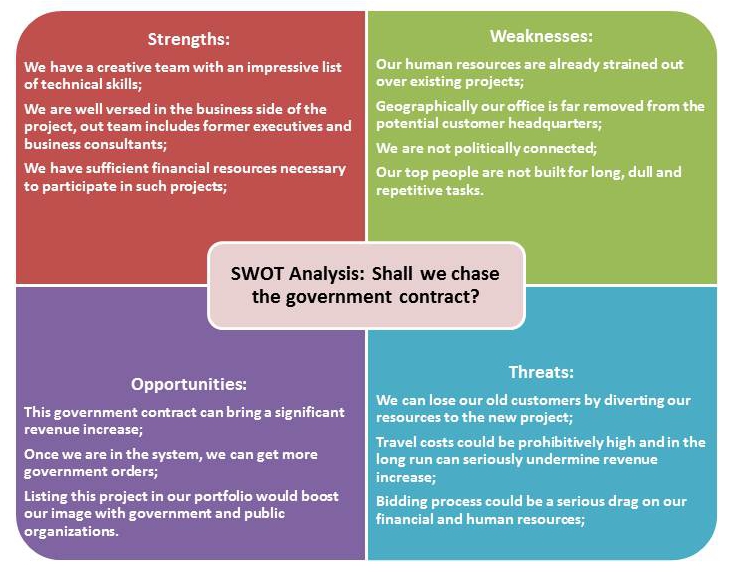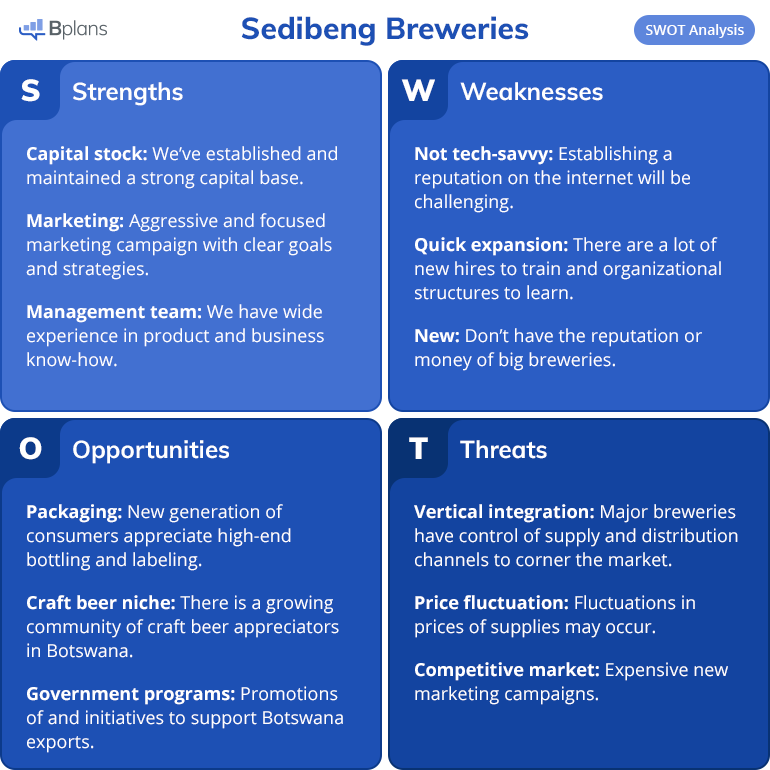

This chapter aims to (i) discuss the current state of the e-Government system in Singapore, (ii) provide a SWOT (strengths, weaknesses, opportunities and threats) analysis of this e-Government system, and (iii) make policy recommendations on how to address challenges, facing e-Government in order to enhance public trust via the effective and efficient delivery of public services. Following the success of the iGov2010 plan, Singapore has recently launched an e-Government Master Plan 2011-2015 (eGov2015), which opens a new epoch of relationship between government and the public. Change in demand for a product, customer preference, economic factors, such as inflation, etc.AbstractE-Government is defined as the utilization of the Internet and other technological means to deliver public services to citizens. External threats include law, the government in case of a new policy, and other businesses supplying similar products to your company. Misuse of resources whilst not yielding returns on profit. Internal threats can be people and poor performance of staff. Remember, threats can be local and external. Threats:įinally analyze threats to both your company, mission, and goals. Carrying out operations globally creates opportunities to have foreign business partners, and workers and boost output for products to increase in sales. For instance, if most operations had been locally based. An opportunity can be that you are the only company that branches to become multinational. One opportunity can be a new product on the market, hence it means you have found an opportunity to generate more income. Opportunities: These are major factors an organization discovers, that will improve its strategic position and competitiveness of the business. That’s an example of weakness during Swot analysis. SWOT analysis and examples for weakness come if you can find anything that’s affecting the growth, effectiveness, and efficiency of your company.

Weakness in marketing strategies and promotion. Common examples are poor delivery of services, lack of communication within the organization, and product quality not meeting customer needs.

Weaknessĭuring Swot analysis, weakness relates to anything that hinders the efficiency and effectiveness of an organization. That’s your strength because at this time no one has managed to do it and it gives your company a competitive advantage. Products on demand, for instance, have been the major supplier of the Coronavirus vaccine. Thirdly location of your company and the type of drug supply. Again another strength is if the government does not interfere in the markets and allows for laws of demand and supply to determine the prices of goods.
#SWOT ANALYSIS OF GOVERNMENT DEPARTMENT FREE#
SWOT analysis and examples for any of the company’s strengths could be tolerance and free entry to the market. But this can only be possible after discovering whats’ really a threat to your business.įor instance, take into consideration you have a company that deals in the supply of medicine. Then the best way would be not to purchase that product you intend to sell. For example an economic meltdown, or loss of value for a product. For instance, if a threat targets the current operation. Ways to control threats include avoiding, mitigating, and transferring. Knowing threats helps develop and way to mitigate and control threats for our business. Do they align with the organization’s goals? Then analyze threats to both your company. Next, find major and minor opportunities. Then move to the weakness, opportunities. Draw and outline the strength of your company. Here’s how to apply Swot analysis and examples for any business or organization: First rule when doing a Swot analysis of a company example. Hence the organization evaluates its options to come up with ways of meeting targets efficiently. Maybe time it takes to reach customers due to poor transport. While some organizations might find the weakness, to be poor delivery of services. If any company has established good customer relations that are noted to be its strength. Derive long-term goals to be archived and measure output, and impact of planned strategies. Public sector and government-based institutions implement Swot analysis, to measure market position, and the threats, which helps interoperate in line with the government’s policies. The techniques are commonly used by the public sector companies, but today because of the need for adaptation of new public management, as opposed to traditional models of public administration.


 0 kommentar(er)
0 kommentar(er)
